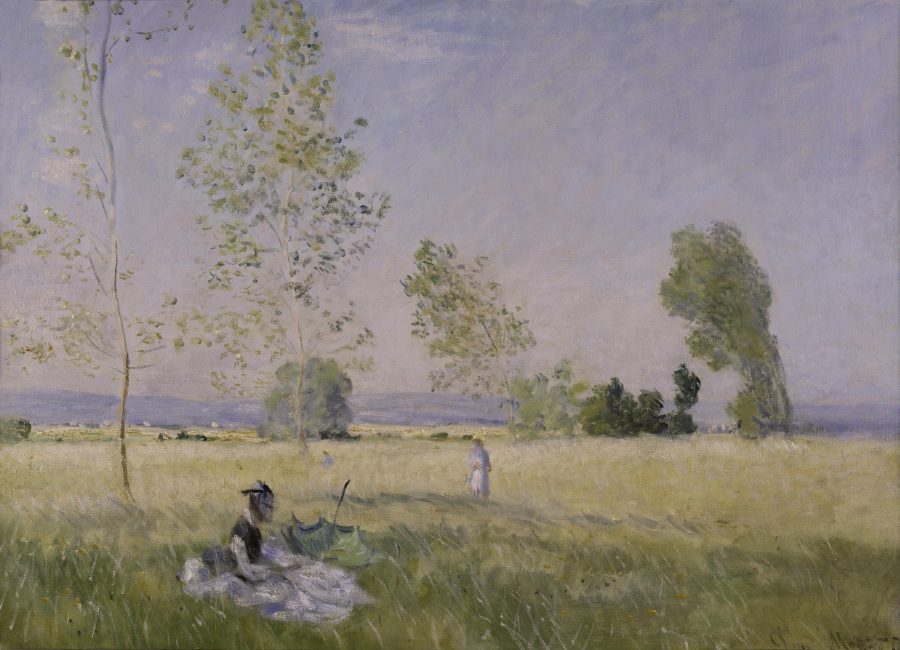I stand before a summer day. Softer, warmer, brighter than the day I’m in. Monet’s vertical canvas, the object of my looking, dissolves, and I am left in space itself. Nature can be this for the mind, a tabula rasa. Hm… I’m not frightened by the vastness, the entrance is not a jolt or a jump, but rather like the gradual tipping that streams tea into a cup. I’m thinking here.
I spent the summer alone in my Reykjavík apartment, and I was visited briefly by a mouse. I followed it out the door, down the steps, into the street, and watched it greet blades of grass and pebbles on its way to a café I frequented to write. We walked in together. I sat in my usual spot, facing the window, and the mouse went home through a hole in the wall. Suddenly I felt embarrassed. The whole space was foreign and I left the café thinking where I ought to take myself instead. The café closed in on itself as I walked away, lost its emptiness, became someone else’s home. There were no real places I wanted to go. I needed immense space now.
I walked around for a while, sat in the sculpture garden attached to Hallgrímskirkja where I knew no one would be. And I thought that I’d like to be in that French summer field. The scene itself is aura, lustrous and remarkably quiet. Like morning dew in grass, it exists undisturbed in momentary beauty and peace. The pale green movement of grass, calm undulation of lavender-grey hills in the distance, hazy figures, translucent peppering of leaves on branches, warm, greyish glow of the sky… they are, in loose textural strokes of paint, the essence of summer present. I wasn’t sure where I’d be when this summer ended. But Monet generously paints an eternal fleeting; the warm summer aimlessness, quotidian, ephemeral, sweet… forever still and a place to visit.
Aloneness exists in relation to emptiness, a self in relation to absence. Three figures populate Monet’s meadow, but they are alone and suspended in vastness. The vastness enwraps them and accepts them as elements of nature and so they do not stand solitary and lonely, but solitary and one with the very texture of the day they live in. I think of my favorite places in the world, the quiet peak of a hike, my house by the sea, a vacant street in a southern Italian town…
If I melted totally into a day, where would my mind go? Where would I be heading towards? The quivering fluidity of the form of the three figures, like flecks of light, keeps from giving them purposive narrative. It is their presence more than any of their individual actions that is the subject in the painting. I can’t find a point of origin, a story of emanation and becoming into the world here. These are not entities growing towards some aim. These people are, like the trees in the wind, simply there. Maybe it doesn’t matter where my mind goes, where my head is heading. To be simply somewhere is it.
At 2 a.m. one summer night I walk around the alleys of Reykjavík, and I hear bottles tap each other and talk, and shoes scuffing up against the curb. But I look down the alley and around the corner and there’s no one there. And houses glow yellow and red from their bellies out with the haze of a darkened figure passing by a window. I know it’s not there. I slow down before the street with the café I used to go to, this street is empty too. I know what’s living in the walls.
I return to this place of Monet because it is densely empty. There’s something invisibly mammoth within it. Perhaps the subject of the painting is wind, the way it confronts the elements of the landscape, how it adds texture to the sky and the field, bends trees, and lifts the pale underbelly of leaves. I am carried by light and air. The painting breathes me in as I breathe it in, fills the canvas with its gentleness and luminosity, fills the lungs. I return to this place to breathe.
During a long summer car ride in Icelandic middle-of-no-where, I look for abandoned houses. These are the rusty shacks of wind and throbbing waterfalls, of ghosts of grumpy fishermen and screeching arctic terns. I spot one nestled deep in the impossible-to-get-to craggily cleavage of a mountain. It’s surrounded by green and sea and stands alone, a single head in the decadence of nature, all for it to observe and be within. Once it buzzed with a real mind, now vacant, it remembers alone. The environment around it changes in colossal motions, never firm in itself, though never drifting from itself. But the shack is no longer who it was when it rusts and crumbles. We pass many lonely old houses in the deep Icelandic wilderness. My father, on a boat somewhere in the bay of Seyðisfjörður, texts me a picture of a solitary rusted house beside a waterfall. “We found your house, it was abandoned in the 60’s.”
This piece was adapted from a visual analysis essay for Geoff Lehman’s course ‘Landscape, Land Art, and the City.’

